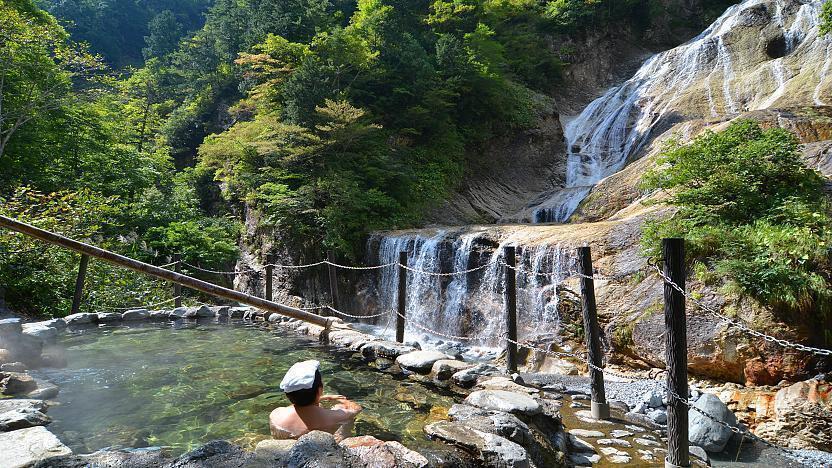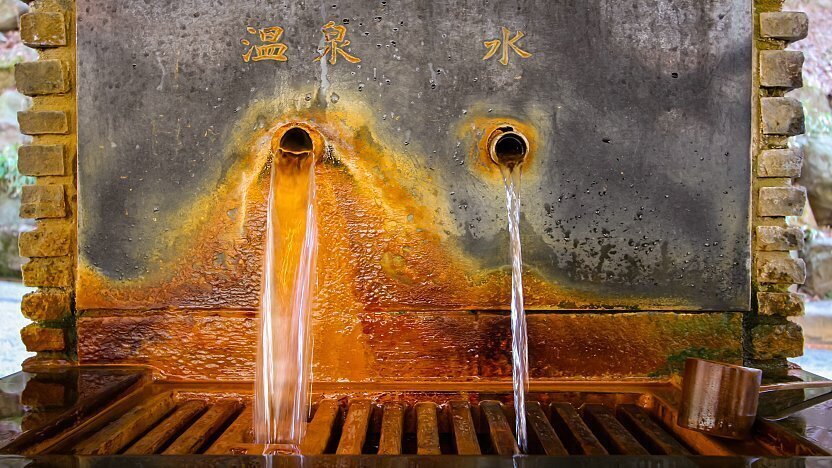Hot Spring Bath Types

Hot spring baths come in a wide variety of styles, shapes and sizes, and are usually made of materials such as wood, stone or ceramic. They range from large indoor pools that can fit a hundred bathers at once to tiny one-man tubs perched on the side of a cliff. The following are some of the commonly found bath types around Japan, but note that not all are used for bathing in the traditional sense:
Indoor baths (uchiburo)
Indoor baths are the most common bath type encountered at Japanese hot springs. They range from traditional wooden to elegant modern facilities and from tiny places with a single tub to expansive bathing halls with a dozen pools.

Outdoor baths (rotemburo)
Many hot spring bathing facilities also offer one or more outdoor baths. What is considered outdoors, however, falls on a spectrum. At one extreme, the baths might be completely exposed to nature, while in other cases just one side or the roof is open to the elements.

Mixed-gender baths (konyoku)
While the vast majority of hot spring baths are gender-separated these days, there still exist some mixed-gender baths here and there, especially in more traditional and remote places. While some of these baths adhere to the tradition of full nudity, many of them allow or even request bathers to use some kind of towels or robes for enhanced privacy.

Private baths (kashikiriburo or kazokuburo)
Private baths, also known as "family baths" can be found in ryokan and some public baths for use by families, couples and other small groups who want to bathe together. They are also an option for those not fully comfortable using the public baths. Many private baths must be reserved and may require a fee to use (typically about 2000-3000 yen for around 40 minutes). Some upscale ryokan offer private onsen baths in their guest rooms.

Foot baths (ashiyu)
Foot baths are shallow hot spring baths with benches for foot bathing. They are often found along the streets of hot spring resort towns and can typically be used free of charge.

Waterfall or beating baths (takiyu or utaseyu)
These are waterfalls or spouts of hot spring water, which are designed to fall from a height to comfortably massage the shoulders of the bather below them. They are a popular feature in larger bathing facilities.

Sand baths (sunaburo)
Sand bathers are buried up to their necks in naturally heated sand. They are provided with yukata robes to wear as they are buried by staff members for around 10 to 20 minutes. Afterwards, bathers wash off the sand and enter regular hot spring baths. Although not very common, some famous places to experience sand baths are Ibusuki and Beppu.

Steam baths (mushiburo)
Steam baths are rare and come either as rooms or huts to be used by multiple people or as small boxes for single persons to sit inside (with their heads outside the box). Steam baths are fed by the steam of a hot spring and can be similar to saunas, which are also commonly found at Japanese bath complexes; however, the conditions inside them are typically more humid and less hot than in a sauna.
Mud baths (doroyu)
Also very rare, mud baths are either entire pools filled with mud that people can enter or hot water baths where mud is provided from a trough to be applied to your skin. Among the few places offering mud baths are some baths in Kirishima, Beppu and Goshogake.

Other uses
Hot spring water is also employed for a variety of other uses such as generating power, heating homes and keeping the roads clear of ice and snow in winter. Other uses more applicable to travelers include:
Drinking fountains
Some types of hot spring waters have health benefits when drunk, and it is not uncommon to find hot spring drinking fountains around popular hot spring resort towns.

Cooking
For centuries, people have been harnessing the heat of hot springs to cook their food. Many foods can be cooked by immersing them in the near boiling springs or by steaming them, which also lends a bit of flavor from the mineral-laden waters. A common offering are onsen tamago (eggs), which have been boiled in hot spring water and puddings and onsen manju (sweet buns) steamed by hot springs. Hot spring cooking is particularly popular in Beppu.

Questions? Ask in our forum.


